Here's how downtown Topeka federal building fits into Joe Biden's clean energy jobs agenda
Downtown Topeka's federal government building will be getting a $25 million makeover to make it more energy efficient.
"I am so pleased to be able to be here in Topeka to announce the $2 billion from the inflation Reduction Act that we are investing in 150 projects," said Robin Carnahan, administrator of the U.S. General Services Administration.
Carnahan and John Podesta, a senior White House adviser on clean energy, visited Kansas on Monday to promote President Joe Biden's "Investing in America agenda."
Topeka's project is also part of a broader effort from President Joe Biden's administration to shift private industry toward more environmentally friendly construction materials.
"The federal government needs to use every tool at its disposal to set the direction, to spur the demand for clean industries and incentivize innovation across the American economy," Podesta said.
Frank Carlson building was ahead of its time
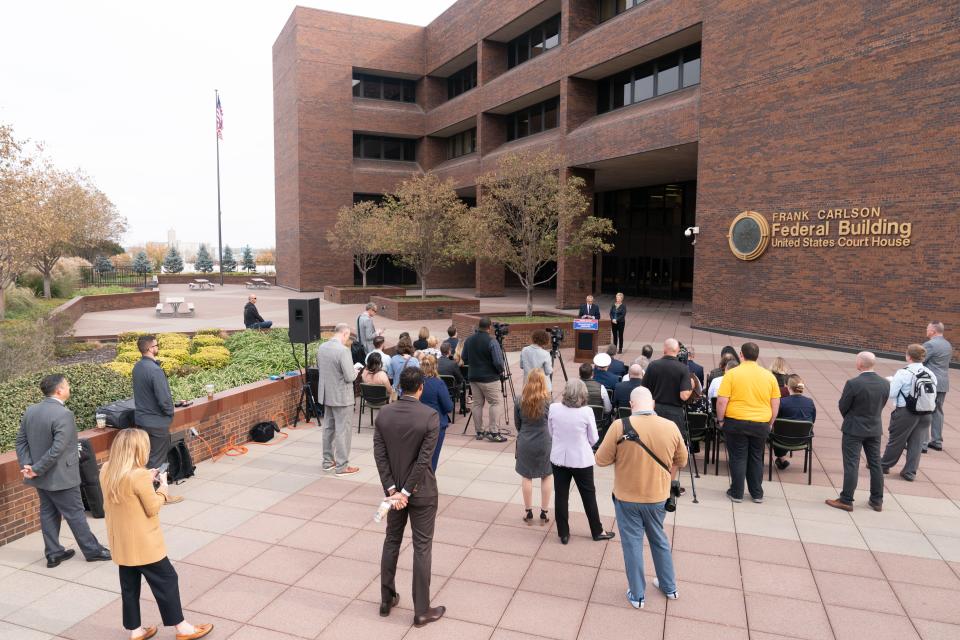
The Biden administration officials announced the construction projects from outside the Frank Carlson Federal Building and U.S. Courthouse, which Maes said was ahead of its time on energy efficiency.
The building serves as one of three federal courthouses in Kansas while also housing federal prosecutors, the U.S. Marshals Service and the U.S. Coast Guard's pay and personnel center.
"This building was constructed in the 1970s," said Denise Maes, the GSA regional administrator. "And because it was constructed during the time of an oil embargo and an energy crisis, this building features many energy saving characteristics that were then and in some ways still are ahead of its time.
"For example, and most notable, this building is all electric, and that was in the 1970s. Well, this great building is about to get better. In about one to two years, this building will undergo renovations that will make it even more energy efficient. And this is all being made possible by dollars from the IRA, the Inflation Reduction Act."
Carnahan said it has "lots of really interesting energy efficiency features already, but we're going to do even more to reduce energy costs."
Frank Carlson building will get $25 million investment
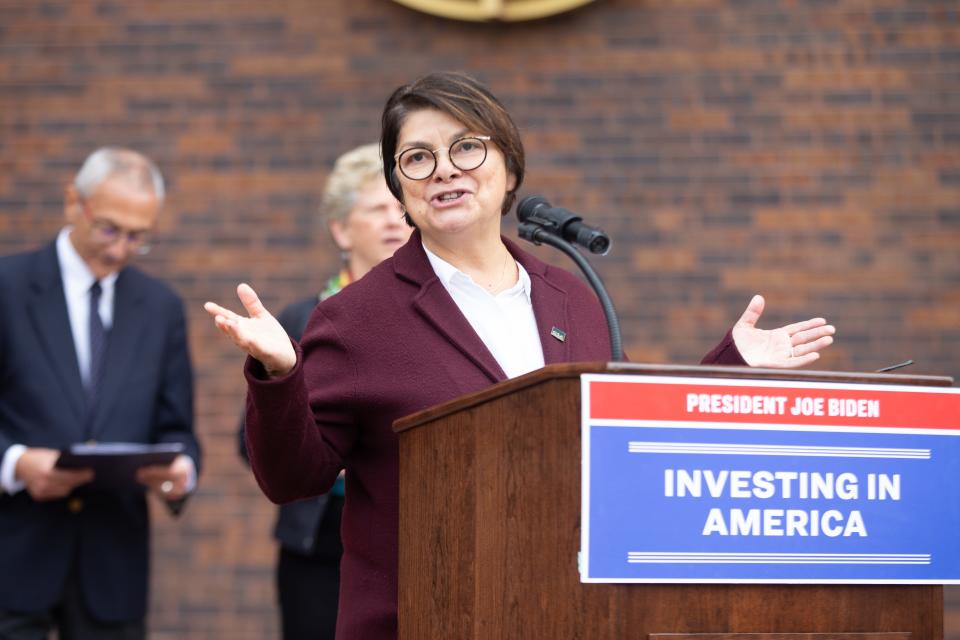
The $25 million project at the Frank Carlson building will use insulated low embodied carbon glass and aluminum frames to replace more than 10,000 square feet of windows and doors with blast-resistant glazing units. The GSA said it will "reduce its greenhouse gas emissions while improving efficiency, safety and comfort" and "reduce the building's energy use and extend the building's useful life."
Low embodied carbon concrete pavement will replace existing sidewalks and parking "to sustainably address deterioration, correct tripping hazards, and improve accessibility."
Also in Kansas, the Robert J. Dole Courthouse in Kansas City, will have a $17 million project to replace nearly 14,000 square feet of glass windows and doors.
"We're talking about renovations that consist of bricks and mortar, glass, facade," Maes said. "These might seem like a very simple everyday construction project, but it's actually much more than that."
Why should Topekans care about energy efficiency at the downtown building?
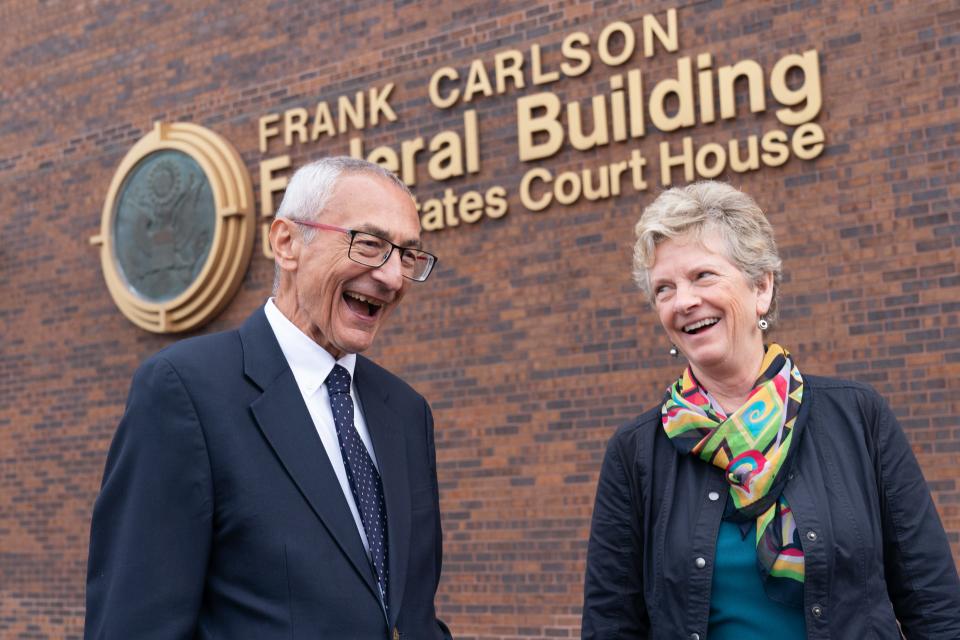
So why should Topekans care about the upgrades to the federal building?
"This is a great example of the government showing what's possible when it comes to having what I always call a triple win, where you can invest in these facilities, create good jobs that are local jobs, make them more efficient," Carnahan said. "Why does that matter? Because it cuts costs for taxpayers and makes the grid more resilient, and the third is that it's good for the planet and for our kids."
It will also benefit workers, Podesta said.
"It'll also make the building more livable for the people who are working inside, for people who have to come to the courthouse on occasion," he said. "It's just going to be not only a cleaner building, but again, a more livable building.
"It'll take a year of planning, and then in a year, you'll see construction workers, local, coming here to reinstall windows, upgrade the building, fix the asphalt with cleaner materials. It'll be a project I think that people can be proud of because it'll be one that is really leading the way for what companies really across the country are trying to do."
What is low embodied carbon and why does it matter?
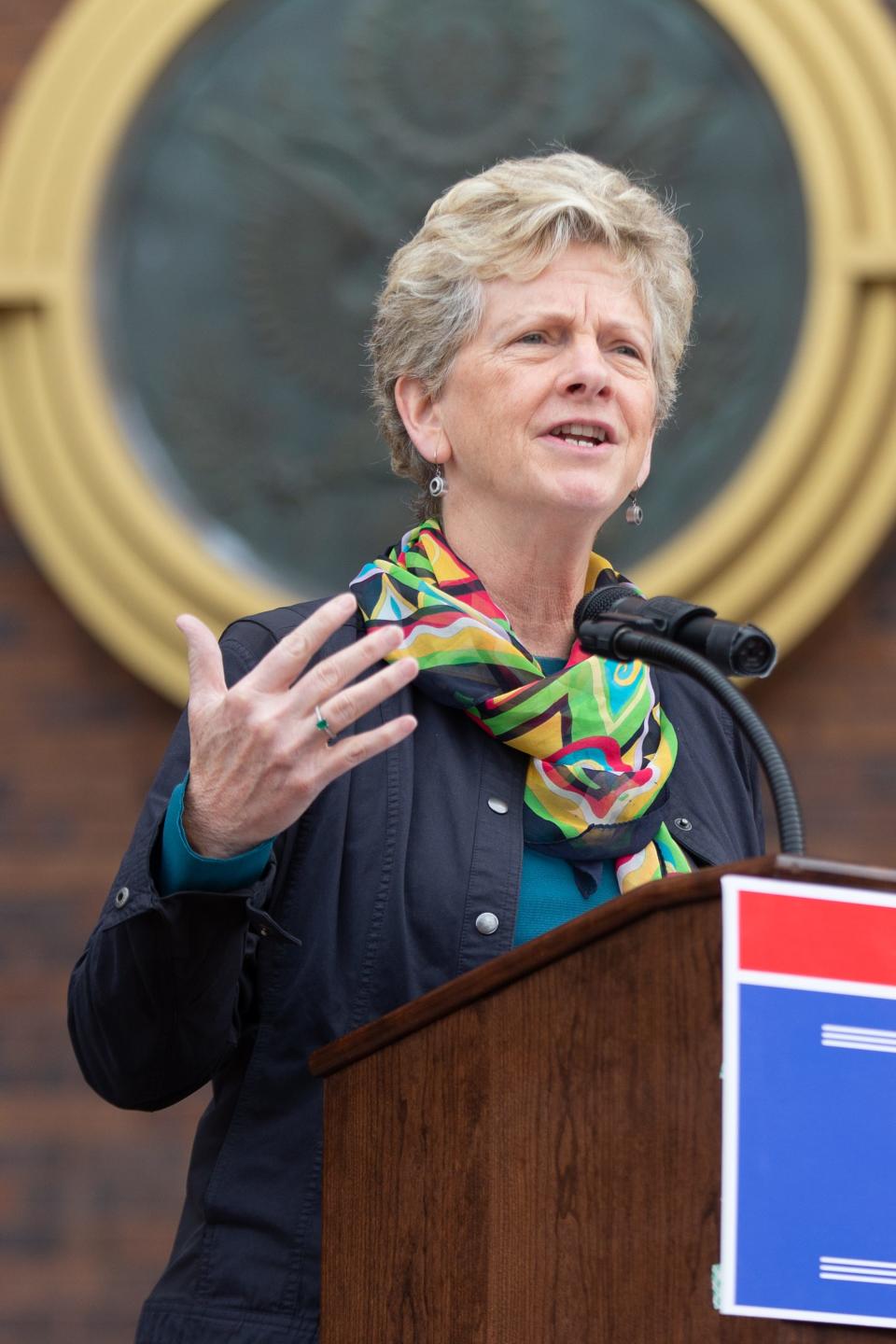
The projects focus on using low embodied carbon, or LEC, materials, which Maes said "are absolutely necessary and critical to fight the negative effects as a result of climate change."
"Low embodied carbon, what does that mean?" Carnahan said. "It means when you're making things in the chain of production that you can reduce the pollution that it takes to make the thing. What we buy a lot of that are very high polluting are glass, steel, concrete and asphalt. And if we can reduce the emissions in the chain of production of those things, it has a huge impact on these buildings and across the supply chain."
Those four construction materials are carbon-intensive and account for nearly half of all U.S. manufacturing greenhouse gas emissions, the GSA said.
In the case of producing environmentally cleaner concrete, part of it is trapping carbon dioxide in the concrete during the mixing process "as opposed to venting it into the atmosphere where it creates global warming, which creates extreme weather, which has the the effects that we've all been talking about," Podesta said.
He said the thought has always been that it is difficult to get carbon out of the industrial processes. Now, the government wants to show "you can get the carbon out of these industrial processes and produce materials in a cleaner way — and that's what we're going to need to do if we want to stabilize the atmosphere by the middle of the century."
The GSA estimates the projects will reduce greenhouse gas emissions by up to 41,000 metric tons.
While in Kansas, the Biden administration officials also visited Geiger Ready-Mix plant near Kansas City to tour how the company produces low embodied carbon concrete. The Panasonic electric vehicle battery plant under construction near De Soto is using its concrete, Carnahan said.
Carnahan noted Girl Scouts videos explaining the concept.
"It's the cutest thing," Carnahan said. "I learned all about low embodied carbon concrete from the Girl Scouts in Wisconsin who have this as their project, which is pretty encouraging for the next generation to be thinking about."
Wielding 'the buying power of the government' to create clean energy jobs
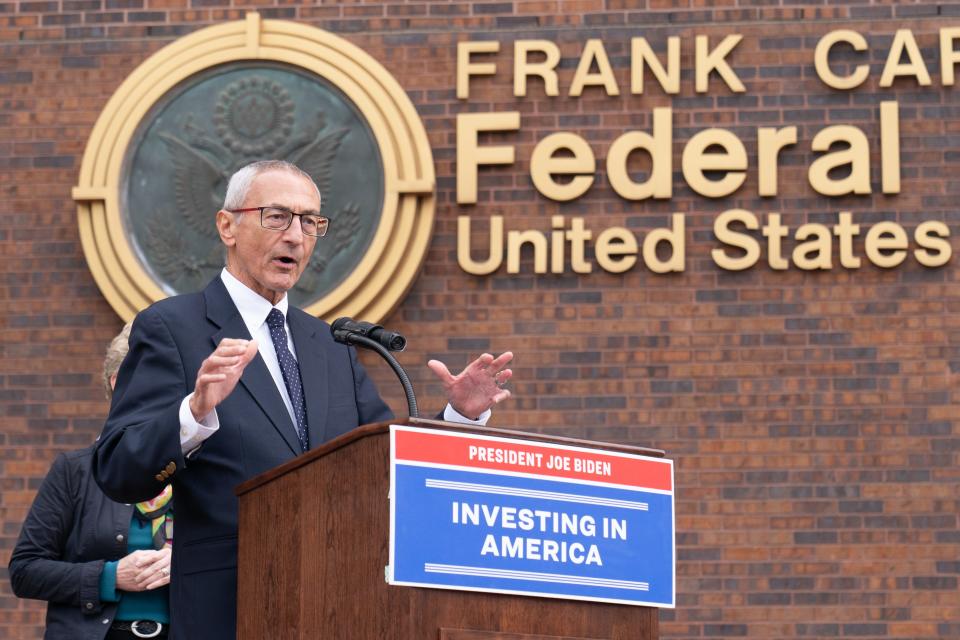
Carnahan said the investments will help create homegrown products and industries in the transition to more sustainable building materials. The GSA projects will create an estimated 6,000 jobs.
"What we're doing at GSA is trying to use the buying power of the government," she said. "After all, we're one of the biggest buyers in the world of goods and services, to use that buying power to help drive these manufacturing and homegrown jobs in industries of the future."
Carnahan said the government has made requests of industry to reduce emission by reusing aggregate and using other technologies.
"The answer is yes, and when I say, 'Well, why haven't we done this before?' they said, 'No one's asked, no one has ever asked us for this before,'" Carnahan said. "That's why it's exciting to be in a position now where we can ask for this, and the industry is saying, 'Sure, we can produce this.'"
Podesta said the government is sending "an undeniable market signal to the private sector" to manufacture cleaner materials in America.
Federal and state government procurement drives half of the demand in the cement industry, he said, and the Biden administration intends to use its purchasing power to prioritize cleaner materials in federal procurement and federally funded infrastructure projects.
"When the federal government uses its purchasing power to drive towards cleaner solutions," Podesta said, "it's really a game changer for American industry, for American workers and communities across the country, and of course for our planet by reducing the carbon load of those of those materials."
GSA views investments as setting a standard
Carnahan praised the funding and momentum behind infrastructure upgrades.
"We all know politicians talk about infrastructure all the time," she said. "That's just a normal thing. But they don't always put the money where their mouth is, and that's what's so different about this administration."
The GSA got $3.4 billion from the Inflation Reduction Act to invest in the agency's 380 million square feet of federal real estate.
Carnahan said the goal is to have the entire portfolio of 8,000 buildings be net zero by 2045, and those buildings can serve as testbeds for efficiency and innovation while setting the standard for the private sector.
"We can invest in those in ways that are smart and save money," Carnahan said. "I talk about it all the time as a triple win, a win for creating good American jobs, a win for reducing energy consumption — which means lower prices and a more resilient grid — and a win for making the planet healthier for our kids."
Podesta acknowledged that clean energy policies have "a political debate about it, but I think the future is in the tremendous investment that we're seeing," touting both wind and solar power.
Carnahan sees that as the future.
"For thousands of years, we have burned things to create energy," she said. "We're now in a place where we're harvesting energy. That's not something that's going to go backwards, we're going to keep going forward on this. Obviously, there's a transition to be had, but this is what government ought to be doing, is showing how it's possible, lead by example and set the private sector up to benefit from this, and all of us."
Jason Alatidd is a statehouse reporter for the Topeka Capital-Journal. He can be reached by email at jalatidd@gannett.com. Follow him on X @Jason_Alatidd.
This article originally appeared on Topeka Capital-Journal: How Joe Biden is using government buying power to promote clean energy

